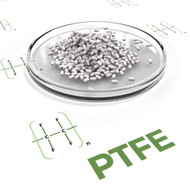Polytetrafluoroethylene (PTFE): History, Properties and Applications
History
The discovery of polytetrafluoroethylene (PTFE) is often described as a serendipitous breakthrough. In the late 1930s, DuPont chemist Dr Roy Plunkett was tasked with developing an alternative refrigerant due to restrictions on existing patents. During the team’s experiments, a container of tetrafluoroethylene (TFE) gas, which seemed to have leaked, was sawed open because its weight suggested the presence of a substance. Inside, they found a white powder that turned out to be PTFE. This fluorinated polymer was patented in the early 1940s and trademarked as Teflon in 1945. In the 1950s, French engineer Marc Grégoire created the first PTFE-coated non-stick pans under the brand name Tefal, inspired by his wife Colette, who suggested using the material—originally intended for fishing tackle—on her cooking pans.
Quick Highlights
- Polytetrafluoroethylene (PTFE) was serendipitously discovered in the late 1930s by Dr Roy Plunkett at DuPont while researching alternative refrigerants. The fluorinated polymer was patented in the 1940s and trademarked as Teflon in 1945.
- In the 1950s, French engineer Marc Grégoire used PTFE as a coating for cookware, creating the first non-stick pan under the brand name Tefal.
Synthesized
PTFE is synthesized through the polymerization of TFE gas, which is derived from petroleum-derived hydrocarbons and fluorine. Key production methods include suspension polymerization (for rods, sheets, and molded articles), emulsion polymerization (for non-stick coatings and thin films), paste extrusion (for sealing applications and electrical insulation), and high-pressure or radiation-induced polymerization. Additives are often used to fine-tune the properties of PTFE-based products. These include reinforcement materials like glass fibers (for improved mechanical strength and dimensional stability) or graphite (to improve thermal conductivity and reduce friction), as well as pigments, lubricants, copolymers, and conductive additives. While fillers can enhance performance, their proportions and processing methods significantly influence the final product’s characteristics.
Quick Highlights
- PTFE is synthesized through the polymerization of tetrafluoroethylene (TFE); key production processes include suspension, emulsion, high-pressure and radiation-induced polymerization, or paste extrusion.
- Additives are often used to fine-tune the properties of the end products, including reinforcement materials, pigments, lubricants, copolymers, and conductive additives.
Tensile Strength
PTFE owes its remarkable properties to the strength of carbon-fluorine (C–F) bonds and the unique attributes of fluorine, such as high electronegativity, low polarizability, and a small van der Waals radius. Despite being relatively soft compared to other polymers, PTFE exhibits excellent mechanical strength and performs well under compressive loads, maintaining its flexibility even at cryogenic temperatures. However, it can deform plastically under prolonged loads due to cold flow, a limitation that can be mitigated with fillers. Its low friction coefficient and non-adhesive nature reduce the need for external lubrication and make it invaluable for applications such as bearings and seals. PTFE’s non-adhesive nature has been exploited in the production of non-stick coatings for cookware, possibly one of the most common applications of PTFE.
Quick Highlights
- PTFE owes its properties to the strength of carbon-fluorine (C–F) bonds and the unique attributes of fluorine.
- PTFE combines excellent mechanical strength, flexibility even at cryogenic temperatures, and a low friction, non-adhesive surface, though its tendency to deform under prolonged loads can be mitigated with fillers.

Chemical Properties
PTFE is chemically inert, exhibiting high resistance to most chemicals, including acids, alkalis, fuels, and organic solvents. It is also hydrophobic and oleophobic, repelling water and non-polar liquids. However, at high temperatures, PTFE may degrade when exposed to molten alkali or fluorine gas.
Quick Highlights
- PTFE is chemically inert, resisting attack from acids, alkalis, fuels, and organic solvents, but may degrade when exposed to molten alkalis or fluorine gas.
- It is also hydrophobic and oleophobic, repelling both water and oils.
Thermal Properties
Thermally, PTFE is highly stable, with a melting point of approximately 327°C (621 °F), and transitions to a gel-like state at this temperature. It can endure temperatures ranging from –200°C to 260 °C (–328 to 500 °F), enabling its use in applications exposed to extreme conditions. Its exceptional thermal insulation properties further expand its application range. However, PTFE’s high coefficient of thermal expansion means its dimensions change under temperature variations, a property that must be considered in precision applications.
Quick Highlights
- PTFE is thermally stable in the range of –200°C to 260 °C (–328 to 500 °F) and has a melting point of 327°C (621 °F).
- It has exceptional thermal insulation properties, but its high thermal expansion requires consideration in precision applications due to dimensional changes with varying temperatures.
Other Properties
Electrically, PTFE demonstrates outstanding insulation properties, including high dielectric strength, low dielectric constant, and minimal dissipation. It is resistant to electrical discharge and maintains integrity in insulating applications.
PTFE exhibits exceptional environmental resistance and excels in durability, with resistance to UV radiation and minimal degradation occurring even after prolonged exposure. Moreover, PTFE is non-flammable and self-extinguishing and demonstrates high resistance to fire, which, combined with its chemical inertness, makes it suitable for outdoor and high-risk environments.
Quick Highlights
- PTFE exhibits excellent electrical insulation, with high dielectric strength, low dielectric constant, and resistance to electrical discharge, ensuring reliability in insulating applications.
- Its exceptional durability, UV resistance, non-flammability, and chemical inertness make it ideal for outdoor and high-risk environments.
Biocompatible
PTFE’s non-toxic and biocompatible nature earned FDA approval for food and medical applications, including implants such as pacemakers and stents. While PTFE itself is regarded as non-toxic, much concern has been raised regarding the use of toxic chemicals in its production, such as TFE gas and, historically, perfluorooctanoic acid (PFOA). The latter is a surfactant linked to bioaccumulation, environmental persistence, and carcinogenic risks, and has been largely replaced by GenX, a similar fluorine-containing compound. Unfortunately, GenX has also been ultimately labeled as a “regrettable substitute” due to significant safety concerns. While PTFE was deemed safe for cookware, other applications have been subject to restrictions. For example, in 2016, the Living Building Challenge red-listed PTFE and other compounds that pose serious risks to human health.
Quick Highlights
- PTFE is regarded as non-toxic and biocompatible, earning FDA approval for food and medical applications like pacemakers and stents, but concerns have been raised about the use of toxic chemicals like TFE gas and perfluorooctanoic acid (PFOA) in its production.
- While PTFE itself is deemed safe for cookware, it has been restricted in other applications.
Sustainability
While PTFE is an important fluoropolymer, its environmental impact is significant. The production process involves the volatile and hazardous gas TFE and PFOA as a surfactant linked to bioaccumulation and environmental persistence. PFTE is chemically inert and durable, which aids in reducing waste and conserving resources over time, it also contributes to environmental persistence when not disposed of properly due to its non-biodegradability. Although recycling efforts exist, they remain limited. Addressing these challenges requires innovative recycling technologies, greener manufacturing practices, and stricter waste management to mitigate PTFE’s environmental impact.
Quick Highlights
- PTFE has a significant environmental footprint due to hazardous chemicals used in its production, such as TFE and PFOA, which are linked to persistence, bioaccumulation, and carcinogenicity.
- Although its long lifecycle helps conserve resources and reduce waste, advancements in recycling, greener manufacturing, non-toxic substitutes, and improved energy and waste management are essential to limiting its environmental impact.
Discover the world of PTFE / Polytetrafluoroethylene within the Material - Nuts & Bolts category. From its unique chemical composition to its versatile applications, explore how this specialized material plays a crucial role in fastening systems. Dive into the intricate world of PTFE / Polytetrafluoroethylene and unlock its potential in various industrial settings.
PTFE hex head bolts offer extreme chemical resistance, low friction, and excellent thermal performance. Ideal for demanding industrial and non-stick applications.





